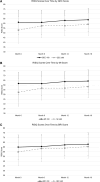Lower Independent Self-Care Readiness Persists Over Time in Teens With Type 1 Diabetes and Executive Function Challenges
- PMID: 38864451
- PMCID: PMC12012708
- DOI: 10.1210/clinem/dgae391
Lower Independent Self-Care Readiness Persists Over Time in Teens With Type 1 Diabetes and Executive Function Challenges
Abstract
Purpose: Management of type 1 diabetes is complex and benefits from adequate executive function (EF) (planning, organization, problem-solving). Teens with diabetes and executive dysfunction may have challenges with the acquisition of self-care skills.
Methods: Over 18 months, parents of teens with type 1 diabetes aged 13 to 17 completed the Diabetes Family Responsibility Questionnaire (DFRQ) and Readiness for Independent Self-Care Questionnaire (RISQ) every 6 months. Parents assessed teen EF, completing the Behavior Rating Inventory of Executive Function (BRIEF). T-score ≥60 defined EF challenges. EF, demographic, and diabetes treatment variables predicted RISQ score over time using longitudinal mixed modeling with false discovery rate adjustment.
Results: There were 169 teen participants (54% male) aged 15.9 ± 1.3 years, diabetes duration 8.4 ± 3.7 years, and A1c 8.6 ± 1.2%. About a third (31.4%) of teens had parent-reported BRIEF Global Executive Composite (GEC) scores ≥60. After adjusting for age, sex, and DFRQ, those with GEC <60 had a RISQ score 4.1 points higher than those with GEC ≥60, P = .016. Metacognition index (MI; adjusted for age,sex, and DFRQ) predicted RISQ while behavioral regulation index (adjusted for age, continuous glucose monitor use, DFRQ, and A1c) did not; those with MI <60 had a RISQ score 5.3 points higher than those with MI ≥60, P < .001. In all models, older teen age (P < .05) and less parental involvement (P < .001) predicted higher RISQ score.
Conclusion: EF skills, especially metacognition, appear important for the acquisition of self-care behaviors in teens with type 1 diabetes. Evaluating EF during adolescence may identify teens needing extra support during the transition process.
Keywords: adolescence; adolescent self-management; comorbidities-neuropsychiatric; transition; type 1 diabetes.
© The Author(s) 2024. Published by Oxford University Press on behalf of the Endocrine Society. All rights reserved. For commercial re-use, please contact reprints@oup.com for reprints and translation rights for reprints. All other permissions can be obtained through our RightsLink service via the Permissions link on the article page on our site—for further information please contact journals.permissions@oup.com. See the journal About page for additional terms.
Figures

Similar articles
-
Ready or not? Greater readiness for independent self-care predicts better self-management but not HbA1c in teens with type 1 diabetes.Diabet Med. 2021 May;38(5):e14507. doi: 10.1111/dme.14507. Epub 2021 Feb 17. Diabet Med. 2021. PMID: 33372275 Free PMC article.
-
Youth With Type 1 Diabetes Taking Responsibility for Self-Management: The Importance of Executive Functioning in Achieving Glycemic Control: Results From the Longitudinal DINO Study.Diabetes Care. 2019 Feb;42(2):225-231. doi: 10.2337/dc18-1143. Epub 2018 Dec 14. Diabetes Care. 2019. PMID: 30552132
-
Assessing readiness for independent self-care in adolescents with type 1 diabetes: Introducing the RISQ.Diabetes Res Clin Pract. 2020 Apr;162:108110. doi: 10.1016/j.diabres.2020.108110. Epub 2020 Mar 16. Diabetes Res Clin Pract. 2020. PMID: 32194216 Free PMC article.
-
Association of executive function problems and disordered eating behaviours in teens with type 1 diabetes.Diabet Med. 2021 Nov;38(11):e14652. doi: 10.1111/dme.14652. Epub 2021 Jul 29. Diabet Med. 2021. PMID: 34273197 Free PMC article.
-
Executive Function Predicting Longitudinal Change in Type 1 Diabetes Management During the Transition to Emerging Adulthood.Diabetes Care. 2018 Nov;41(11):2281-2288. doi: 10.2337/dc18-0351. Epub 2018 Aug 21. Diabetes Care. 2018. PMID: 30131398 Free PMC article.
Cited by
-
A Conceptual Model for Understanding the Division and Transfer of Diabetes Care Responsibilities Between Parents and Children with Type 1 Diabetes.Healthcare (Basel). 2025 May 14;13(10):1143. doi: 10.3390/healthcare13101143. Healthcare (Basel). 2025. PMID: 40427979 Free PMC article. Review.
-
Teens with Type 1 Diabetes and Executive Function Challenges Who Use Insulin Pumps Have Lower A1C Without Increased Risk of Diabetic Ketoacidosis or Severe Hypoglycemia.Diabetes Technol Ther. 2025 Jun;27(6):460-468. doi: 10.1089/dia.2024.0574. Epub 2025 Feb 6. Diabetes Technol Ther. 2025. PMID: 39912799
References
-
- Sperling MA, Laffel LM. Current management of glycemia in children with type 1 diabetes mellitus. N Engl J Med. 2022;386(12):1155‐1164. - PubMed
-
- Miller KM, Foster NC, Beck RW, et al. Current state of type 1 diabetes treatment in the U.S.: updated data from the T1D Exchange clinic registry. Diabetes Care. 2015;38(6):971‐978. - PubMed
-
- Hannon TS, Janosky J, Arslanian SA. Longitudinal study of physiologic insulin resistance and metabolic changes of puberty. Pediatr Res. 2006;60(6):759‐763. - PubMed
-
- Suchy Y. Executive functioning: overview, assessment, and research issues for non-neuropsychologists. Ann Behav Med. 2009;37(2):106‐116. - PubMed
MeSH terms
Grants and funding
LinkOut - more resources
Full Text Sources
Medical

